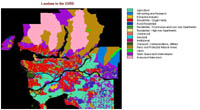
data collection
*After viewing images, simply hit back on the browser to go to the particular section you were on in this page or else it will reset to the top which can be annoying.
commercial area
A new business is more likely to be successful if it is placed with other businesses. This increases exposure and ease of access. To begin my analysis, I first had to determine which areas were commercial and not commercial. A good data set for this was available from the SIS lab network of the SFU Geography department. I used Landuse in the Greater Vancouver Regional District that was already in IDRISI raster format. See enlarged image.
population of males and females aged 15 to 30
According to figures in Snowboarding Business magazine, the demographics show that the average age of snowboard riders is 23.3 years. Only 0.3% are over 65 or under seven years old, the largest making up the 13 to 17 age group (30.7%) and the 18 to 24 age group (46.7%.). I decided to make an age group between 15 and 30 years to cover the general target audience. The data I used to create this layer came from two sources that had to be linked and converted to IDRISI. One being an ArcView shape file on enumeration areas of the lower mainland from the network, and the other, Census Data from the Research Data Library webpage. See enlarged image1. See enlarged image2.
yearly average household income of at least $50000
Snowboarding is an expensive sport. There is much gear that comes with it as well as a price tag that all adds up. I have decided that households having a yearly income of at least $50000 are more likely to invest in the sport than those who may not have as much room in their budget. This was created later in my analysis. Like my population layer, the data I used to create the income layer came from two sources that had to be linked as well and converted to IDRISI. One being the same ArcView shapefile on enumeration areas of the lower mainland from the network, and the other, Census Data from the Research Data library webpage. See enlarged image1. See enlarged image2.
street network
Other constraints considered in determining suitable locations pertain to transportation. A data set was available from the network as an IDRISI vector layer which had to be converted into raster. This vector layer basically showed all of the streets in the lower mainland. This would become important later as I digitzed points for the existing snowboarding shops as well. See enlarged image.
access to Skytrain
Another contraint considered for ease of access to the new shop. This layer was available from the network as an ArcView shape file which had to be converted into IDRISI. I used a translator software program called FME to do this. I then had to convert it into raster in order to do my analysis as with all the other vector layers. See enlarged image.
locations of existing snowboard shops
The final constraint considered was the location of competing stores. For a snowboard shop to be successful, it is necessary to be located near other like shops. Data showing competing shops was not available, so I manually digitized the points as a vector layer onto the road image. The vector layer was then converted into raster. See enlarged image.
main | conceptual outline | data collection | methodology
spatial analysis | problems & errors | about the author